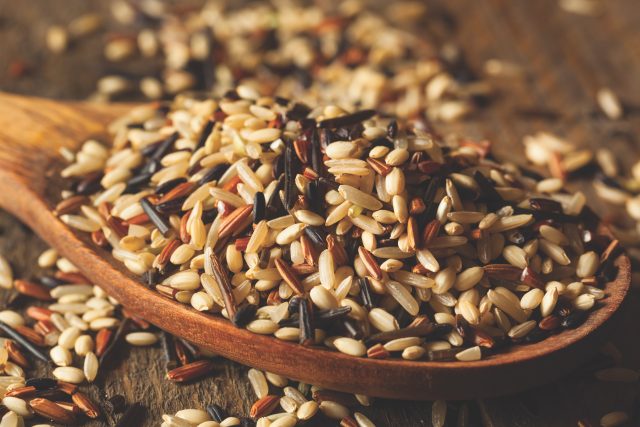
I met the wild ricer behind a ski lodge near Lake Tahoe. We were there for a writing workshop, reading each other our work.
He was, and is, a hunting guide in Northern Wisconsin named Nick Vander Puy. He read about a father and son team of Chippewa Indians from inner city Milwaukee and their trip to a lake to collect wild rice, using cedar “ricing sticks” to knock the seeds into their canoe.
Wild rice isn’t actually rice, but the kernel of a large aquatic grass native to the lake country of northern Minnesota and Wisconsin, extending into Canada. Like the people of that northern landscape, it’s more rugged and earthy than its soft, domesticated counterpart. Wild rice has a nutty, tea-like flavor, and a texture that pushes back when you chew.
Soon after the workshop ended, Vander Puy got his story picked up by NPR’s All Things Considered. The piece I’d brought to the workshop, a passionate essay about Christmas tree farms, never went anywhere, but I hung onto the idea of real wild rice, and started cooking it.
Wild rice became a window into wild foods, an area I wanted to explore. I joined the rice hunters vicariously, in their expeditions, when I ate it. I thought about their efforts not only to collect but process the rice, as the wild ricer described in Vander Puy’s radio story: “The ricers get a fire going, under a propped-up galvanized wash tub. They pitch in several handfuls of rice, taking turns stirring the seed heads with a wooden paddle. The smell of burning plants fills the camp. This process, called parching, slightly roasts the rice, preserving it, and loosens the husk from the wild rice kernels.”
Modern wild rice
Hand-harvested wild rice is hard to find, and expensive when you do. Farmers have figured out how to cultivate wild rice in paddies, the same way real rice is grown. Today, almost all of the wild rice sold is paddy-grown and machine-harvested, mostly in California. To find the real wild stuff, you need to find a ricer who is willing to sell you some.
The wild rice community is divided over this domesticated wild rice. Vander Puy says the paddy-grown stuff isn’t comparable to hand-gathered wild rice in terms of flavor, texture and overall performance in the kitchen. As a seller of wild rice and a friend to many other sellers, he laments the fact that paddy-grown rice has disrupted the market for the real stuff, which costs twice as much.

Most people cook wild rice until it’s soft enough to eat, but some prefer to soften it with an overnight soak. Hand-gathered wild rice tends to soften (and cook) more quickly than paddy-grown wild rice.
However long it takes to soften, soaking wild rice is worth a try. The flavor of soaked, uncooked wild rice is milder than that of cooked wild rice. You can wash down your chewy mouthfuls with sips of the earthy, fragrant soaking water, like swallowing a pristine lake in the middle of the forest. For extra vibrancy, add a handful of pomegranate seeds. The juice will burst out as you chew them with the hearty rice, adding tartness to every bite, like little sips of wine.
If the soaking method fails to soften the rice enough, you can always cook it. For years, my go-to preparation was to mix it, still hot, with smashed garlic, sesame oil and soy sauce, and garnish with chopped scallions. The heat of the rice cooks the garlic enough to remove the edge, for a flavor that’s exciting and comforting.
I also prepare a wild rice with mushroom dish I learned from a wild-mushroom picker while camping near Montana’s Blackfoot River. Eating wild foods in wild places is a special experience that’s hard to replicate anywhere else. But even cooked indoors, on a stove top, with domestic ingredients, this dish will channel the wild side of rice into your kitchen.
Morel Camp Wild Rice
1 cup wild rice
2 tablespoons unsalted butter
2 tablespoons extra-virgin olive oil
2 cloves garlic, smashed
2 tablespoons pine nuts
2 cups chopped mushrooms (a mix of varieties is ideal)
1/2 teaspoon salt
1/4 teaspoon freshly ground black pepper
1/2 cup pomegranate seeds
Serves: 6
Prepare the rice the day before. Add a cup of wild rice and two cups of water (or stock) to a pot with a tight-fitting lid. Soak overnight.
Reserving some of the rice water, simmer rice on medium-low or bake at 350 degrees for 30 minutes. Check progress. If the liquid is nearly gone and the rice remains hard, add more liquid. Keep checking, adding more liquid when necessary, until the grains split, curl and bloom like tiny brown and white flowers. Continue cooking until all moisture is gone, but don’t allow the rice to dry out.
Combine butter and olive oil in a large skillet or wok on medium heat. Add the pine nuts and mashed garlic. Cook just until they start to brown. Don’t overbrown. If the pan gets too dry at any point, deglaze with reserved water from the rice.
Add the mushrooms and stir. Season with the salt and pepper. When the fungus starts to brown and weep, add the cooked rice, stirring gently.
Transfer the rice onto a large plate. Garnish with pomegranate seeds, and keep more pomegranate seeds on hand to sprinkle on as a condiment.














